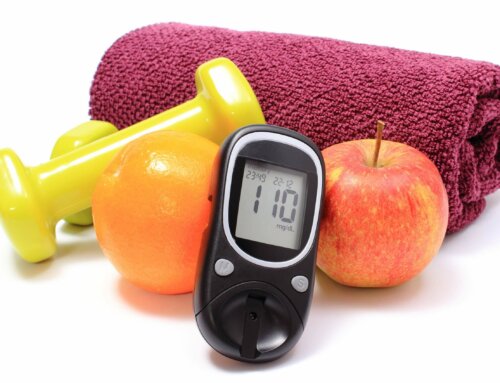Change can be very stressful and difficult for patients, especially right after the holiday season. Taking on too many new goals with lots of limitations can result in instant failure. Most people think the average holiday season weight gain is between 8-10 pounds. Studies done at the National Institutes of Health (NIH) and the University of South Carolina state that “the typical weight gain is really between 1-1/2 pounds.” The problem is when that weight is carried over from year to year; ten years later, you are still up the same 10-15 pounds.
This will increase insulin resistance and make it more difficult for your insulin to do its job of allowing glucose to enter the cells. That equals elevated blood sugars and higher A1Cs. Try to set up a plan of small changes with a manageable time frame; you will be more apt to keep up.
I wanted to offer easy time saving and healthy tips for you to start the New Year; hopefully you will achieve instant success. Remember, you are human, and set backs are normal. Refocus your attention each time and forge ahead!
- Grow your own spices – Many patients complain of lack of flavor in their foods when they are asked to lower the sodium content. Hypertension is often found in patients with diabetes. It may sound difficult and time consuming, but there are spices already in home containers, ready for you to use, which add exotic and interesting taste. If highly motivated, you can start an outdoor garden and grow spices in the soil. There are spice window boxes which are easy to maintain and readily available. You can leave pre-potted spices on your counter and snip off a piece to turn a simple meal into a delicious one without adding salt. Try basil, oregano, tarragon, mint, parsley and rosemary.
- Make it sweet and light – Adding half and half or flavored creamers to your coffee can really put on calories quickly and add to weight gain. Coffee is now totted as a benefit for blood sugars, but not with tons of creamer. Most of these creamers have about 35-40 calories per tablespoon and often people end up adding up to ¼ of a cup for light coffee. Drinking creamer 3-4 times a day can really put on weight and the flavored ones can raise blood sugars. There are sugar free creamers, which may have added unhealthy fat. Try buying flavored coffee instead which has a great taste with no added calories. These delicious flavored coffees now come in individual pods, instant individual sticks, and regular size coffee bags or cans.
- Cooking oil may be healthy, but… – Although healthy, monounsaturated oils (including olive or canola oil) are 100 calories a teaspoon. People tend to add more oil to re-coat the pan. You may often forget about these calories since they soak into the food. Try an oil mister, which is readily available at most stores and just adds a hint of oil, or you can eliminate the oil completely. Cooking with low sodium broth (chicken, vegetable or beef) will increase taste and moisture with very few calories. Save the high quality oil to drizzle over salads.
- The perfect food: eggs – They are often called the perfect food since they are cheap, a great source of protein and easy to prepare. The guideline for people with elevated cholesterol remains “4 egg yolks a week”. I often recommend substituting egg beaters or egg whites which come in prepackaged containers. There is no wasting of the yolk. These are great products to add to casseroles or to make a quiche. A whole egg is 70-80 calories with 6 grams of protein, and an egg white only has 15 of those calories with protein. New research suggests “eggs may boost your metabolism”.
- Cereal lovers rejoice – You may think that cold cereal is a no-no, but as long as you watch your portion size and choose a cereal with high fiber, you should be able to keep it as part of a complete breakfast which also includes a protein. Look for cereal that has 60 calories per ½ cup serving and at least 5 grams of fiber. I teach patients who are still eating Frosted Flakes, Sugar Smacks and Fruit Loops and do not know why they have elevated blood sugars – 2 hours after their breakfasts! Try a cereal like Fiber One, which has 60 calories and 14 grams of fiber for a ½ cup serving. Look for oats, bran and whole wheat varieties, and eat a protein with the cereal like cheese, eggs or almond/peanut butter.
- Choose from grocery store hot/cold food bars – Many chain stores now offer fresh food bars including soups, salads and hot food selections. You can combine them with home cooked foods, since these items can be time savers if you make smart selections. Pick the chicken vegetable soup instead of the macaroni and cheese. Look for steamed pre-cooked cruciferous vegetables including broccoli, cauliflower, cabbage or Brussel sprouts. Find cooked barley, brown rice or quinoa. Add canned and rinsed beans (soluble fiber) for protein and fiber and you have a complete meal. Be sure to watch your portion sizes, since grains and beans count as carbohydrates.
- Get whipped or light – Purchase whipped cream cheese, whipped butter, cool whip or whipped yogurt which is lighter, has less calories and fat with decent taste. Buy light yogurt, light olive oil mayonnaise and light salad dressings. Buy tomato sauce with no added sugar, or make your own with fresh tomatoes and spices.
- Dust off your slow/pressure cookers – These products are somewhere in your kitchen cabinets. They can make it quick and simple to prepare healthy complete meals. Get online once you find them and choose diabetes-friendly slow cooker meals. Some meals require only 4-5 ingredients, can be thrown together in the morning, and make the house smell terrific at the end of 6 hours. You can then serve immediately.
- Pre-cooked meats – Definitely watch the sodium content, but a rotisserie chicken saves my life at least once a week. Serve as is, or pull apart and make into a tasty casserole. Remove the skin to lower fat and calorie content. There are so many selections of pre-cooked meats, such as poultry and fish, which will simplify your life and create a hot meal without picking at junk food waiting for dinner to be served. The prices tend to be higher because of convenience, so you need to weigh the benefits.
- Leftovers – Many of my patients are eating out more than 3-4 times a week. We have previously discussed that these foods may contain more salt, fat and sugar but if this is your lifestyle, at least make a choice to split the entrée or bring ½ of it home. Think about your restaurant choices. Take-out food can also be purchased when time is limited, but try to keep it simple without a lot of gravies and sauces and watch your portion sizes. Buy a 12-inch sub with turkey and fresh vegetables instead of the “meat and cheese lover’s sandwich” and use for 2 meals.
- Freeze/simplify the recipe / everyone pitches in and pre-plan – When meals are planned and prepared for the week, you will definitely make better choices, grab less junk food and feel less stress at dinner hour.
Change takes time, but these tips may help you get started in the New Year and get you on your way to improved health habits. Best of luck!
NOTE: Consult your Doctor first to make sure my recommendations fit your special health needs.







Why are you writing about calories and fat? Calories don’t matter to diabetics. Carbs do. Diabetics do much better on high fat, low carb diets.